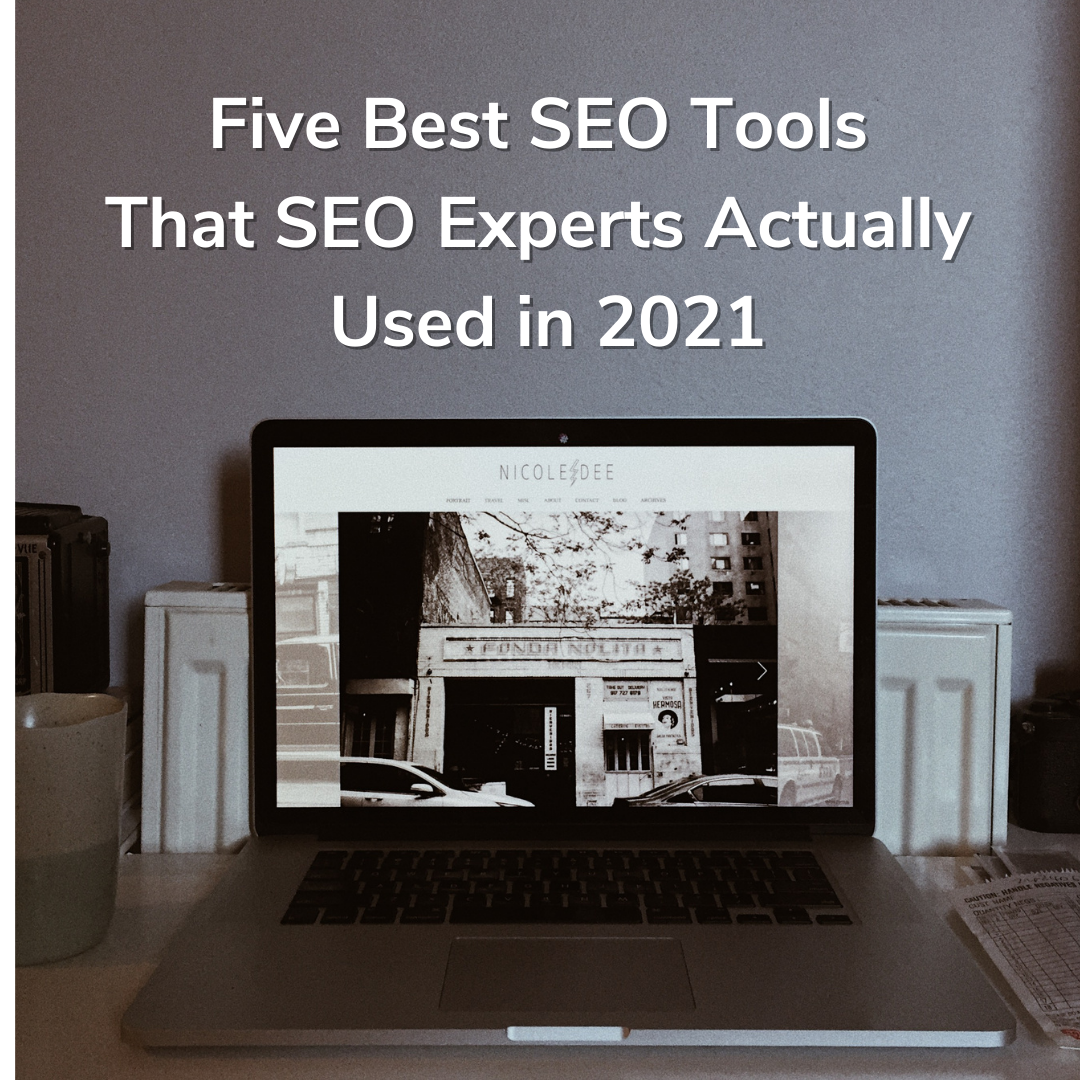
Welcome to “The Power of the Inbox for Nonprofits” Tips and Tricks for Successful Email Marketing.
FYI the recording of this presentation was created for “The Association of Fundraising Professionals of Volusia/Flagler County Florida. Visit their website to learn more at:
It was my pleasure to be a speaker during their luncheon on March 8, 2017 at the LPGA clubhouse in Daytona Beach FL. I sure enjoyed meeting and connecting with all the wonderful nonprofits that are adding such value to the community.
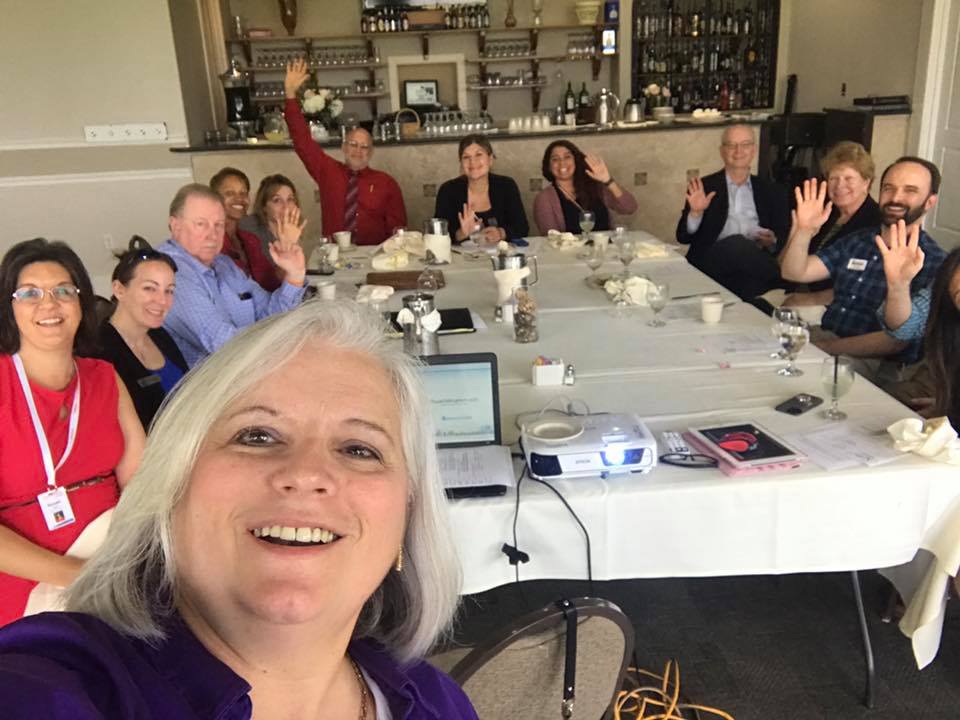
Our topic was all about email marketing with a focus on nonprofits. Everyone in attendance was already using Constant Contact with the exception of one nonprofit was using their own website service for their email campaigns. They admitted the downfall for them was not being able to monitor the “spam reports” or a few statistics. However we were all on the same page about the importance of email marketing and staying on “Top of Mind” with our donors and supporters.
I will be happy to offer my assistance going forward to all of the nonprofits in their organization once they are in the “PowerSellingMom” network. How to join? Easy, just shoot me an email saying “Please add me to the PowerSellingMom network. My Constant Contact user name is: _____ and my Constant Contact email is _______ “Easy Peasy!”
Once your in the “PowerSellingMom” network, simply use my appointment scheduler (found at the bottom of my website in the footer section) and schedule a free 45 min consulting call. We can jump on a webinar or speak by phone. I will be happy to walk you through whatever help you need. Or if you just have a quick question, email me anytime!
NOW, onto the transcripts of the presentation:
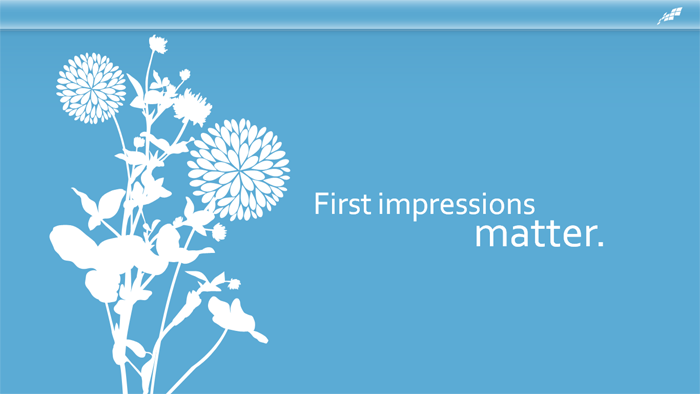
First impressions matter. And when someone opens your email, what they see is going to determine what they do next. Chances are you’ll want them to read your newsletters or announcements, and take a next step. Maybe you want them to visit your website, volunteer, register for an event, or donate to your nonprofit. This is where a beautiful, professional-looking email designed to drive action is crucial. People make snap judgements about whether or not to read your emails based on a quick glance, because all of us get a lot of email. We choose an email message, give it a two-second glance, then decide if it’s worth our time. If it is, we keep it and read it. If not, we hit the delete key and send the email to the trash folder.
I want to show you the difference between a regular email from your own Outlook, Gmail or Yahoo account, and one sent through an email service provider like Constant Contact.
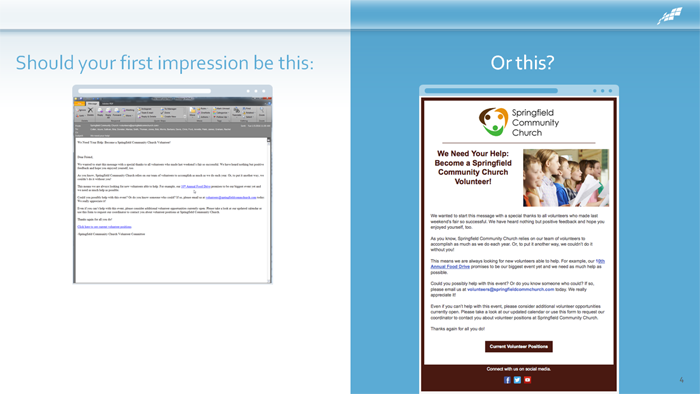
An email from a service provider looks better and gets you noticed– you can use it to feature your organization’s logo and colors, and include graphics that will capture your readers’ attention – all of this, including the graphics, comprises email content. With a combination of text and great images, you will get through to your audience. And, from a purely legal and practical perspective, an email service provider will help protect your messages from being considered spam. You can also get more email delivered to your audience’s inboxes using an email service provider.
For all of the reasons I have just listed, I want you to understand that you need to use an email service provider to do email marketing the correct way.
Check out the email on the right – the colors and graphics make the message eye-catching and more professional-looking than the one on the left. It also makes the call to action much more obvious, and that’s what we are after at the end of the day with our email marketing….Actions!
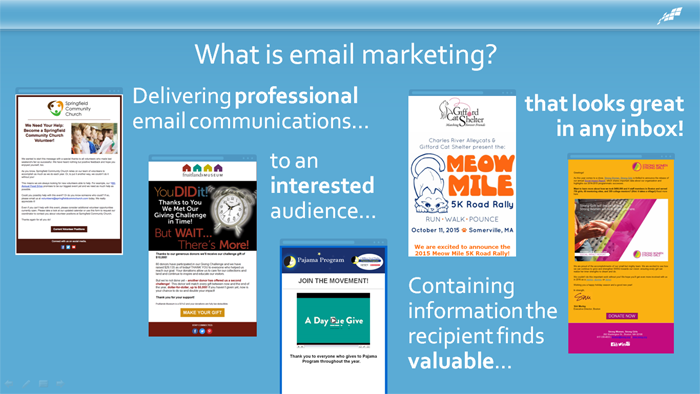
So email marketing defined at its base level is:
1.Delivering professional communications: Making sure that we are getting great looking branded emails with no grammatical and spelling errors into the inbox.
2.To an interested audience: This is very important because someone can easily report our emails as SPAM or delete them. We need to make sure that the individuals we are adding to our email lists expect to receive a communication from us. Setting this expectation is vital.
3.Containing information the recipient finds valuable: Just because you have permission to communicate to someone doesn’t mean you will be successful with email marketing. You also need to be sending the right information to the right people on your email lists. Knowing what your audience needs or wants can be tough. Is it promotional messages? Is it informational messages? Is it a combination? If you are unsure, you may want to ask your audience, survey them, ask them on social media, or when you or your staff have interactions with them in person. Many times this will lead you to understand that you may need to segment your list to send different messages to different audiences, more about that later in the presentation.
4.That looks great in any inbox: With so much email being read on smartphones and tablets, you need to create an email that will look good on a laptop, desktop, and a mobile phone.
What can it do for your nonprofit? “DRIVE ACTION”
Email is a great way to bring people back to you that have volunteered with you, attended an event, or donated to your cause. Remember, you have invested money, time and energy to acquire these people and they have already had a positive experience with you. It is much easier to ask for revenue with this audience, than bringing brand new prospects along.
What can it do for your nonprofit? “CREATE AND INCREASE AWARENESS”
If you do a good job building your list (much more on this later today) you will have quite a few people on your list who need to be nurtured until they trust you and have enough interest to participate or donate. Email is an amazing way to continue to touch those potential volunteers, members or donors over the course of time until they are ready to start a relationship with you. One of the reasons your list is so valuable is that you can’t predict when someone will be ready to take that step with you, and if you deliver valuable information over the course of time, more prospects will trust you, and email is the most cost-effective way to communicate with your potential supporters over time.
What can it do for your nonprofit? “BOOST DONATIONS”
As I just mentioned, email is amazingly cost-effective, and can help drive revenue and interest directly from your communication if you choose to inform, promote, push someone into the trusting stage with your expertise, or solicit a donation!
HARNESS THE POWER OF THE INBOX!
OK, trivia time. Question: What do you think is the #1 app on cell phones?

The answer is EMAIL.
Let’s talk for a minute about the importance of mobile on email. 64% of adults (AND GROWING) own smartphones and as a result, more than 51% of emails are opened on a mobile device. In some countries, mobile internet usage is even out-pacing desktop internet usage.
In fact, more people own a cell phone than own a toothbrush! Out of the 6 billion people on the planet, 4.8 billion have a mobile phone, while only 4.2 billion own a toothbrush!
So what does this mean for you? Many people are reading their messages – which include your emails – on a tiny screen. So keep mobile in mind as we move through today’s presentation.
————————————————————————-
Source: 51% of emails are now opened on mobile (Litmus, January 2014) https://litmus.com/blog/email-client-market-share-where-people-opened-in-2013/litmus-email-client-market-share-2013-infographic
Source: Out of the 6 billion people on the planet, 4.8 billion have a mobile phone, while only 4.2 billion own a toothbrush, https://60secondmarketer.com/blog/2011/10/18/more-mobile-phones-than-toothbrushes/
Email marketing is hard to beat.
It’s where everyone is these days for everything from updates from your bank or service providers, to messages from mom or the kids and of course promotional messages from businesses you subscribe to and frequent.
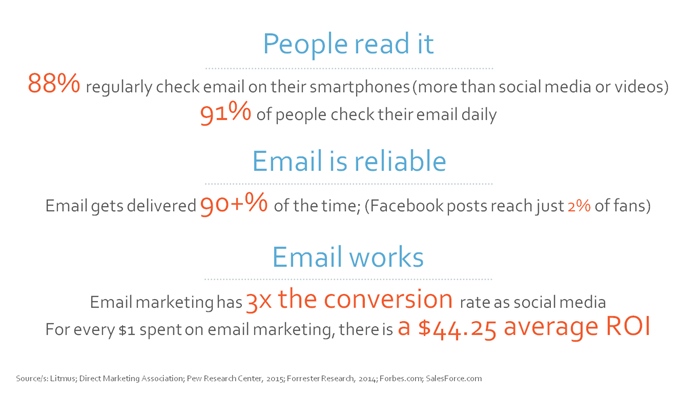
People are in their inboxes all day, every day because it’s easy to access through their smartphones.
- Email marketing is more reliable than social media marketing. You have control over what your message looks like, who you’re reaching, and when you want to reach them. Social networks have their own rules about who sees what posts and when. They typically don’t reach everyone in your audience. In fact, Facebook posts reach just 2% of fans.
Now, this is a stat that is relevant to small business, but think about the donations and actions you want to generate for your nonprofit. Email marketing has three times the conversion rate as social media marketing.
Why Regular Email Doesn’t work
No matter what you’re using – Outlook, Gmail, AOL, Yahoo or Hotmail – you are limited to the number of people you can send to. Plus, if you don’t remember to enter the email address in the BCC/blind carbon copy field, everyone can see the names and emails of everyone on the message, and that’s a privacy concern. An email service provider lets you send to everyone on your list at the same time, without sharing their information with your entire audience.
– There’s no control over how your email looks. You can’t do any special formatting or guarantee that it will look great or look the same in every inbox.
–Your messages are more susceptible to SPAM filters by using regular email services. A bulk mailing from a personal address raises red flags.
You don’t have the ability to brand your messages to have the same look and feel of your other digital marketing efforts.
People are wary of bulk messages sent from personal addresses. You may get SPAM complaints from your audience.
And regular email services don’t give you tracking or reporting information. You don’t know how many people opened your emails, who opened them, who and how many people clicked on your links, or what time and day your messages were opened. You don’t have results to measure whether or not your campaign was successful.
Email Marketing
automates best practices for you -
and makes you look great!
An email service provider has built-in features to make your marketing easier and makes your organization look professional and sharp!
– When you use an email service provider, you have access to beautiful, mobile-responsive, easy to use templates and tools.
– These professional emails reinforce your branding identity, and help you establish your brand visually through your marketing messages.
– Messages sent through an email service provider are addressed to each recipient by themselves. They don’t have to worry about their information being shared with strangers. You can also use features to greet the people on your list by name, and that makes your emails feel more personal.
– You have the ability to organize your lists. You can add new subscribers with easy signup tools, manage email addresses that are bouncing your messages, and allow your audience to unsubscribe and give you feedback.
– An email service provider with a good reputation ensures that your emails get delivered, gives you reporting tools so you can keep track of your results, and complies with SPAM regulations.
LIST BUILDING
How do you grow a healthy email list? Well, it’s all about how you ask and where you ask people to sign up. And yes, you have to ask. People might not know about your list or might not think about signing up unless you bring it to their attention. And they already know you and like you, so there’s a good chance that they will!
Permission is a critical part of the email marketing process, and there is legislation in place in the US and Canada that governs how we can email the people on our lists.
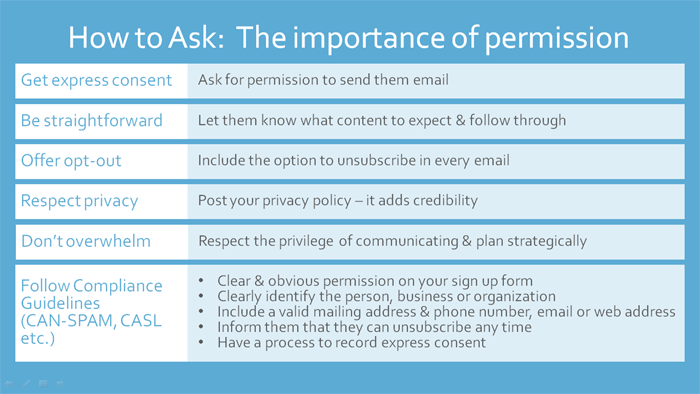
Ask for permission in all touch points of your sales process. This could be a checkbox when someone is buying from your website, or you simply asking a question in a face to face interaction.
– When you ask for permission, take advantage of the opportunity to set a couple of expectations. You can tell them how often you will be in their inbox, and also the type of content they should expect. If you do this well and follow through, you will have more success.
– Make sure you have an option to let your contacts unsubscribe in every email that you send. Remember that one of the big advantages of using an email service provider is that the unsubscribe functionality is automated for you!
– Posting your privacy policy is a great way to set your contacts or potential contacts at ease when they are joining your list. It helps them feel that their data is protected. Again, this is something that email service providers like Constant Contact specialize in.
– Treat your subscribers like you like to be treated in an email relationship! Make sure that you aren’t emailing too often. If you set good expectations and deliver value, this part is easy.
– Follow these compliance guidelines. Make sure your signup forms are clear that whoever joins your list is giving you permission to communicate with them. All of your signup tools should clearly identify your organization. Provide contact information. Let potential subscribers know that they are able to unsubscribe if they wish. Have a process to record express consent for subscribers. If they sign up electronically, they are giving you consent. If you use paper signup forms, keep those records.
There are lots of ways to gather contacts.
Collect email addresses at events: Events are a great way to gather email addresses. When people register, make sure you provide a checkbox for them to select if they’d like to receive email communications from you. Another way to leverage events is to hand out swag in exchange for an email address.
At speaking engagement: If you are a featured speaker at events, make sure you gather as many business cards as you can while passing yours out with a way to subscribe to your list on them. Constant Contact has a QR code feature or Text-to-Join tool that you can use to make it easy for people to subscribe using their mobile devices. You can include that information on your cards. After the event, upload these new contacts and include them in your automation emails, welcoming them to your list by thanking them for subscribing. If you’ve had great conversations with these people, certainly send them a special email reminding them that you had met at a particular event and thanking them. It will leave a lasting impression.
Add a QR scannable sign-up code to your table tents: Add these to tables at events. Or if you have a waiting room or front deck in your building, this is a great place to gather contacts. People will be waiting for their appointment or event, so give them a way to subscribe right from there.
On paperwork or paper distribution materials: Include an option to subscribe to your list in enrollment paperwork, and make sure there is an opt-out checkbox for any email collected. It should be an opt-out rather than an opt-in (you’ll collect more emails this way).
Print QR Code on paper distribution materials: Put your QR code signup tool on everything that you print that makes it into potential subscribers’ hands! Your business card, your brochures, ads in the paper or in local magazines, on posters. If you’re in the US, add your Text to Join keyword and unique phone number to these materials with a request to subscribe.
Use a fishbowl on your front desk to collect business cards: Tried and true, this technique still works! Offer a monthly drawing for a free gift or service or swag with your organization’s logo on it. Put this where people can see it, and make sure it looks as full as possible. This helps to encourage people to “go with the crowd,” and add their business card to the bowl. If you’re using the fishbowl, make sure you are organized and uploading those contacts regularly.
Use a signup sheet in gathering area: If you have an activity room, board room or function room at your location, have a signup sheet there. When large groups of people are in these areas, you’ll have a better chance of getting new subscribers.
But really, just ask.
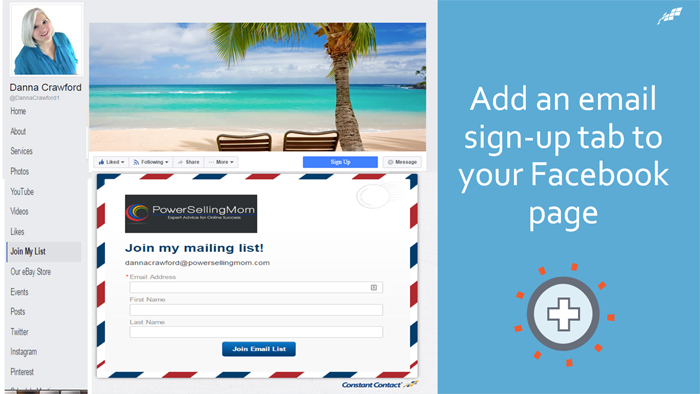
With Facebook as the largest social media site around, this is a great place to collect email addresses. The Constant Contact Facebook app installs directly to your page, which allows fans or visitors to opt into your list. Remember, it is never a good idea to assume everyone who likes your page wants to receive your emails. Installing this app will allow visitors to subscribe themselves, so you know you’re reaching everyone who wants to hear from you.
Facebook also allows you to add a button at the top of your page, this can easily be linked to your email sign-up form from Constant Contact. That way your visitors will have multiple opportunities to sign-up.
The best part about using the Constant Contact Facebook App is that you don’t have to manage any incoming email addresses. We’ll save you time by automatically collecting new contacts and adding them to the list of your choice. Easy peasy!
Creating Great Content
Your email messages to your audience are not actually about you. They’re about what you know or what you have access to that will make your organization interesting and valuable to them.
– Focus on being relevant. Make sure that you know what your audience values. Do the research by asking or surveying your audience. What type of information would they like to receive in their inbox? If you don’t get any interest in routine email letters from your board of trustees, you might want to stay away from that content and stick to what your audience wants to know, not what you want to push out.
– Figure out how much content is enough. Keep in mind that a majority of people will be reading your emails on their mobile phones. They don’t have time to scan through an endless list of items and articles. Make your messages relevant, short and focused. Your email shouldn’t be telling recipients every single thing that you do, and it shouldn’t include extraneous information. If you have a lot you want to share, publish it all on your website. Then, in your emails, write a sentence about the topic and link to the full information on your website. This is a win-win. Your audience can quickly look at the topics you’re offering and then the link drives them to your website, where they may spend more time and look around. Plus, you can track who and how many people click your links and determine what topics drive the most interest.
– One of the easiest ways to create content is to listen to your audience’s frequently asked questions. Many times they are similar, and it’s important to remember that YOU are the expert in your field, and your customers typically are not. These questions can be amazing sources of content. Try doing a “FAQ mailbag” section to your newsletter when you need content.
– Don’t forget that images can be content too. Pictures of events, staff, and outreach work very well. Make sure that you optimize for mobile, and that images don’t dominate your content.
I’ve mentioned relevance, and here’s why it’s important that you include content that’s for your audience, not for yourself. You don’t have to send all of your information to all of the different roles you work with. An update on board meeting materials or a letter to board members can be sent to a list of your board members, and not your entire list that includes volunteers or donors, who may not be interested. A reminder about an upcoming event should be sent to the people who registered, and not to your entire list. Anyone who already registered may be concerned that their RSVP was lost.
38 percent of email recipients will unsubscribe if they think the content in your email is boring or irrelevant – and when a person unsubscribes, you won’t be able to communicate with them again.
32 percent will send irrelevant content to their spam folder, which could impact how email providers, like Gmail or Yahoo, sort your future messages.
——————————————————
Source: https://www.marketingsherpa.com/article/chart/why-subscribers-flag-email-as-spam
Let’s talk about how much content you should include in your email. Think about it. How often do you look forward to reading a long, detailed email? Not very often, right? You’re looking for something concise and easy to read – what’s the news, what are the details of events that are happening, is there any action I want or need to take? – and that’s what you should think about when you create your own emails.
When it comes to email content, less is more. Always.
There is no rule that says your newsletter needs to have three articles, three pictures and three links. One thing is plenty. There is actually a Constant Contact customer whose newsletter is called One Thing – he did it to make it easy on himself and it works really well – people can absorb it and he’s not under the gun to come up with a bunch of content to fill it.
We did a study of our customers and found that the best practice is to limit yourself to 20 lines of text and three or fewer images. This is a great time-saver for your organization! You don’t need to worry about sending a ton of information every time you communicate.
Source: Constant Contact study: https://news.constantcontact.com/research/constant-contact-data-reveals-direct-correlation-between-email-campaign-effectiveness-and-n
Turning your interactions with your members, supporters, volunteers, and donors into content for your email.
Think for a second about the last interaction you had with someone at your organization. What questions did a donor, supporter, volunteer or recipient have? What information are people requesting about your nonprofit? Can you turn an answer to their questions into an email?
Here are some great examples.
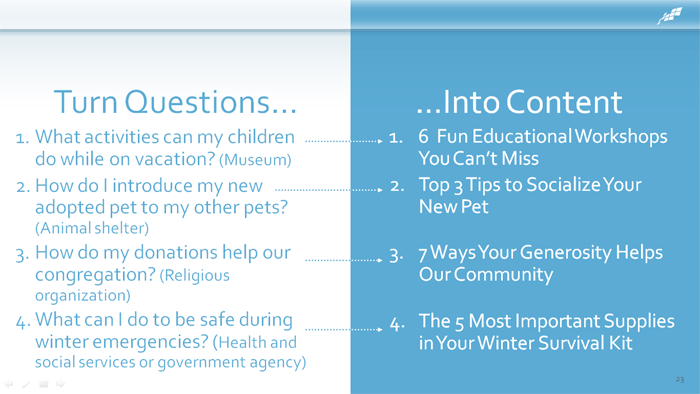
One easy way to practice this in real life is to create two columns, in a spreadsheet or document, or just on a piece of paper, with the questions you regularly get on the left. In the right column, write down a way you can turn the answers to those questions into an email full of fresh, relevant content.
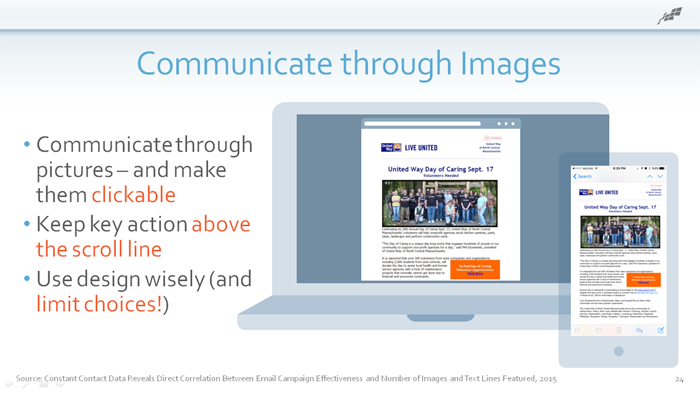
You’ve heard that a picture is worth 1,000 words. In your email, you can communicate through images as well as text. Turn your images into clickable links, so that when your readers click on your images, they will be directed to the action you want them to take. Just make sure you also include a text link to the same location, because about 67% percent of email readers will not see images by default.
Email tools like Constant Contact make it easy to assign a URL to your images, and also to add “alt text” so that a description of the image appears, even if the reader doesn’t see the picture.
Side note – try to avoid giving too many choices in your campaign. These are supposed to be quick decisions to act. Too many choices will reduce the number of decisions or actions a person can take.
Create a beautiful, mobile-friendly template that matches your brand
Start off right by choosing a mobile-friendly, one-column template so it can be easily read by people viewing your email on their smartphones.
– Make sure that you’re using your logo and the colors that you use in the rest of your marketing, so that you’re immediately recognizable.
Use great images of your organization and your supporters so that your audience can easily connect what your organization does with who you are.
And make sure you use consistent language across all of your marketing so that people will not be confused.
Don’t be afraid to use the same content and images across your email, website and social media posts – the more your organization meets your audience where they are, the more likely your audience is to keep you in mind.
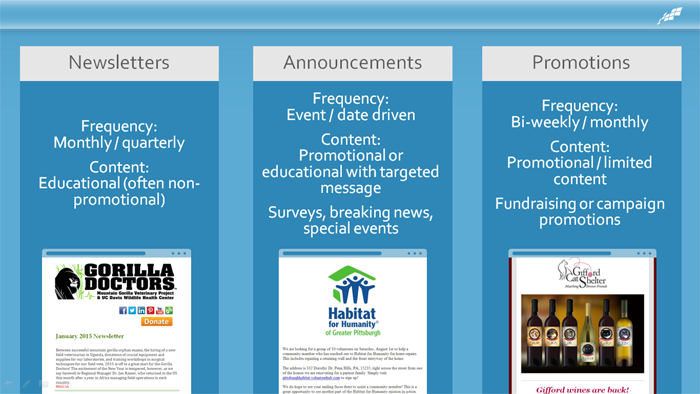
Templates make the process of creating and sending emails much easier, while still allowing you to preserve the look and feel of your brand. Here are some examples of how different nonprofits use the right email templates for their messages.
First, we have newsletter templates, which typically showcase your news and expertise. Remember you are giving away good information for attention. Use the teaser paragraph strategy. If you have a whole article of content, tease the first few sentences and link to the rest of the content online. This will help you keep the newsletter short and readable on all platforms including mobile.
You can also use templates to share announcements. These may not be easy to plan on a calendar, so make sure they are special when you send them out. The messages in announcements could include your nonprofit winning an award, receiving a large donation, a special event, or some breaking news that impacts your audience.
Many nonprofits also send promotional emails about fundraising efforts. In these types of emails, make sure that you don’t give too many choices. You want someone to take a quick action.
Get Your Emails Opened
When you’re creating your next email, follow this recipe for success. These tips are based on Constant Contact’s analysis of over 2 million Constant Contact customer emails. This is the recipe for the most effective email campaign:
1. – Use a single column template so your email will be easily viewed by people opening it on any device – mobile, tablet or desktop.
2. – Include images to drive visual interest, but don’t overload readers with visuals. Three or fewer is enough.
3. – Don’t overwhelm your readers with text. 20 lines or fewer are plenty to get your message across. Got more to say? Include the full article or information on your website, and use your email as a “teaser.” Include a few lines of text from the information, and link back to your website. This will drive readers to your website and your email reports will show you useful information about what links were clicked by your audience, and which ones are most popular.
4. – Speaking of links, don’t offer more than 3 to 5 links. The more choices people have, the less likely they are to click because they may have trouble deciding what they want to do next.
5. – Keep the main action you want people to take above the scroll line, which is the top part of the email people see when it’s visible in their desktop’s preview pane, or in the screen of their smartphone. If you put your important action below that portion of the email, people may not read to the end and see or act on what you want them to do next.
We know the email inbox is a busy place. What can you to ensure that your message gets attention?
– Be a recognized sender and be consistent with your name and organization branding.
– Include a compelling subject line so your audience knows this is a message worth reading.
– Be strategic about the day, time and frequency of your messages to arrive in the inbox at the best possible moment.
– Provide your audience with the ability to share your emails with their friends and family through social media.
How do you accomplish this? Let’s look at some best practices and tips.
Who sent the message is one of the factors that make people stop and open your email in their crowded inbox.
Think about how you sort your email. Typically when you open up your email – think about it this morning – you start at the top of the list and you go down, sorting by who it’s from.
Who the email came from turns out to be the most important part of winning the battle of priorities in the inbox. You do it based on who, so it’s important for you to [CLICK TO BUILD] be recognizable.
You do need to exercise care and consider how you’re identifying yourself across the marketing tools you’re using. If you send your emails as “Jane Doe,” but your Facebook page shows up in people’s newsfeeds as “The Springfield Library Fund,” people might not make the connection. Just be sure that you’re consistent with the name you use, and ensure that it’s the one that you’ll be recognized by, so that ultimately your readers and followers will stop and open your email, read your posts because they know they’re going to get something of value and relevance from you.
The second reason to pay attention is the subject line. As a nonprofit, you don’t have time to do things that don’t work, so when it comes to your subject lines, you want to get into the habit of optimizing your subject lines to get the best results possible for your marketing efforts every time.
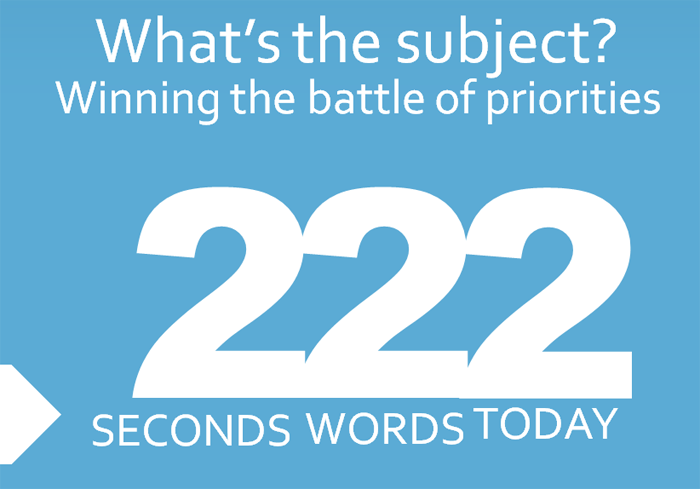
Approximately one third of people decide to open an email based solely on the subject line so it needs to be a standout subject line that grabs their attention, whether they’re reading on a desktop computer or a smartphone or tablet.
Source:
35% of all recipients of email choose whether or not to open a message on the subject line alone. – inwise “The Magic Words: The Importance of the Subject and ‘From’ Lines for Email Marketing” (2012)
The best time and day also depends on what industry you’re in.
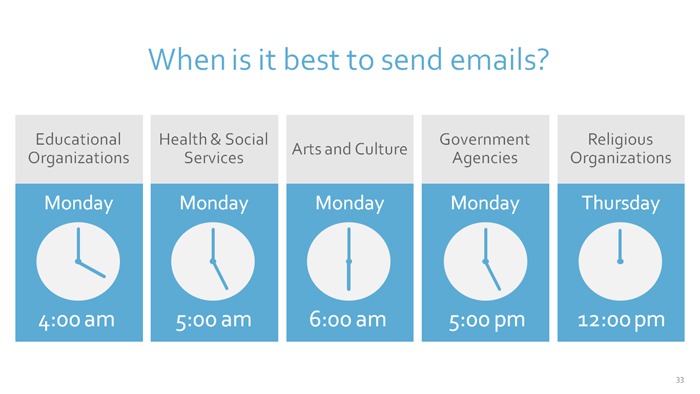
And when it comes to nonprofits, the best time and day varies among different types of organizations. We analyzed millions of emails across 33 different industries to give you this kind of insight! Many nonprofits had a best day to send on Mondays, including educational organizations, health and social services, arts and culture, and government agencies.
And, surprisingly, early morning send times performed best across the board – 5am-8am are the sweet spot.
So what could this mean? What we found is that it could mean a 6% increase in open rates. 6% – just by scheduling your email to go out at an optimal time!
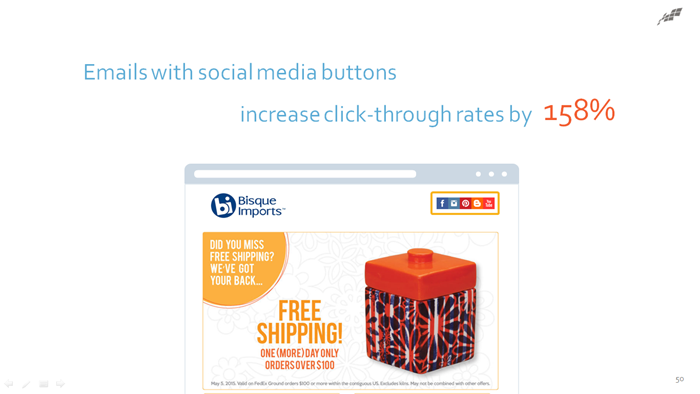
Encourage your audience to share your emails by using social media tools. This is a really effective way you can grow your reach. Emails that include those social sharing buttons increase click-through rates by more than 158 percent!
– If you are using Constant Contact, add the Share Bar to the top of your emails. The Share Bar allows your readers to post a link to your email on their social media profiles
– Remind your audience to share your emails. Ask them to Like them on Facebook, retweet them on Twitter, or pin them on Pinterest.
– And add social media buttons that link to your business’ social media profiles. The buttons are a nice visual reminder for them to click and follow you online.
Your audience has a lot of influence via word of mouth, and you can get your emails in front of more people – their friends and family – if they help spread the word for you.
SOURCE: Visualistan, Latest Social Media Statistics Infographic https://www.visualistan.com/2015/04/latest-social-media-statistics-infographic.html
Measure The Results
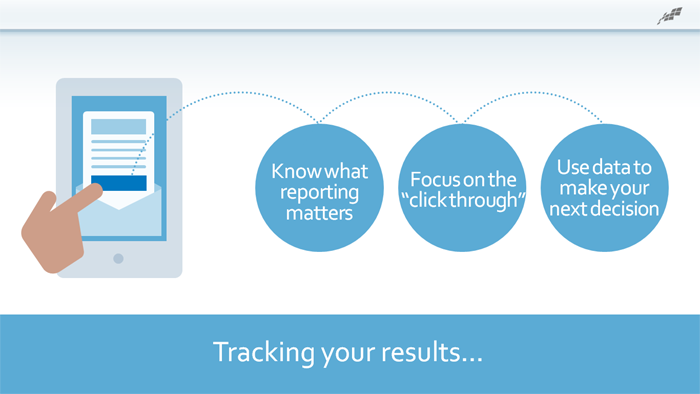
No matter what kind of email marketing message you send – newsletters, announcements, promotions, event invitations, breaking news, donation solicitations – they will all have one thing in common. That’s click-throughs.
It’s important to measure actions. Click-through rates measure exactly what actions your audience is taking. This metric tells you so much. It gives you an idea of what content people like, what topics they’re interested in, what calls to action work, what keywords appeal to your readers, and what multimedia is interesting to them.
What you ultimately want to do with click-throughs is drive people back to your website, your social networks, to your organization’s physical location. The campaigns you create need to have calls to action that take them to your properties so that they will continue to learn, read, watch, comment, donate and engage with your nonprofit. You’re keeping your organization top of mind and growing your relationships.
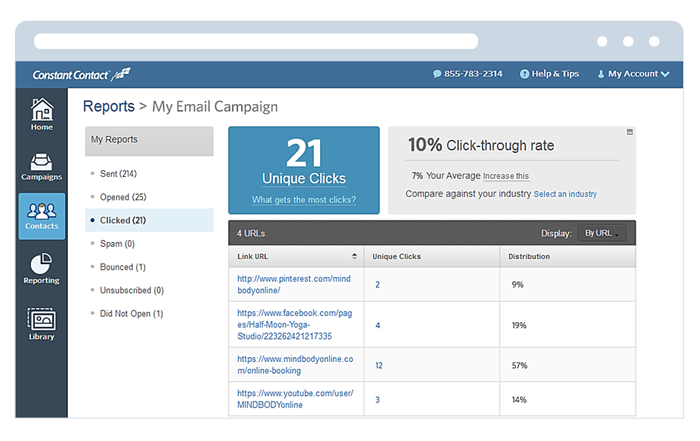
So what? It’s good to see all of that, but what do you do with these results? Let’s look at a scenario.
[CLICK TO BUILD] You’re reviewing your reports for an email, and discover that you had a high open rate, but a low click through rate. This means that people were opening your email, but looks like they were not engaging with your content once they opened it, or following your call to action.
Let’s start with the high open rate. It’s a great result, but there are things you can do to make it even better:
The first is to find out what’s the best time and day to send your emails. When you look at your open rate report, you’ll see what date and time each of your readers opened your email. Start comparing that to the day and time you send your email – you should send your messages at the day and time your readers are opening them. They’ll be more likely to check their email then and see your message.
Next, take a look at your subject line – what keywords do you think were interesting to your audience? Think about the keywords you’ve used in your subject lines, in blog posts, on social media, and in your website that draw your audience’s attention. Keep using them in your subject lines.
Also consider segmenting your audience by interest. You can create separate email lists for different audience interests, and send emails that talk about the topics they like. They will open emails that talk about their interests in the subject line.
Now – the low click through rate. How can we improve it? It’s showing that our audience isn’t interested in the links that were offered in the email. Here’s what to do next:
Review your calls to action in your email. Consider the wording in your call to action – is it clear? Is it telling people exactly the action they should take and do they get a sense of why it matters to them?
Look at your email template and design. Is it mobile friendly? Use a mobile friendly template or you can choose a one-column template so your message is easily read on a mobile phone. If there are multiple columns, they might shrink to fit, and that results in tiny text that readers have to pinch and zoom to expand.
Think about how much content is in your email. People don’t have time to read long emails and if they’re on a mobile device, they don’t want to scroll! Also, if you have too many articles, you might have too many links and calls to action. When you give people too many choices, they’re not sure what they should click on, and might not click on anything.
Let’s look at a different scenario: What should you do if you had a low open rate and a high click through rate? This tells you that although not many people opened your email, the ones who did were very interested in your content.
Why might you have a low open rate?
Your timing and frequency could be off. We talked about this with the high open rate – are you sending at the times and days that people would be most likely to read your email. Are you sending too often? Are you not sending enough?
It could be an issue with your subject line. Is your subject line compelling enough? Does it contain keywords that appeal to your audience’s needs? Do you get to the point of the email in a few words? Watch your subject line’s length – if it’s more than 6 to 10 words, it could get cut off by your recipients’ email services or smartphones.
The email’s content might not match up with your audience’s interests. As you review your open rate and click rate, you’re learning more about what content and keywords they respond to. Send emails about the topics they like, and don’t waste time creating content they won’t read.
A high click rate is fantastic. Your audience wants to know more about the resources you’re linking to in your email. Here’s a few things you can do to make your click rate even better:
Format your links so they stand out when your readers open your email. Use buttons or put white space around them. Make sure the links are spaced out for mobile readers – if they’re too close, it’s really easy to click on the wrong link with your finger.
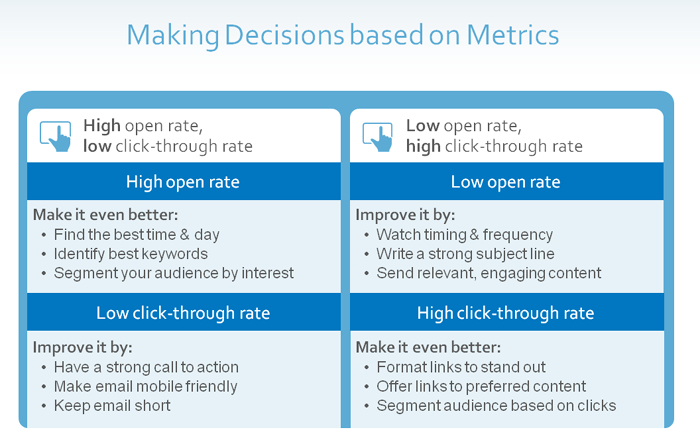
You’re using these reports to get to know your audience better, so keep track of what’s getting the most attention in your emails. Narrow down the links you offer to fit the topics that they want to read about.
The last thing you can do is take that knowledge of your audience and segment them. Your reports allow you to view the people who clicked on individual links and create a list from them. Segment your audience into different lists, and target them with relevant content.
Putting It all Together
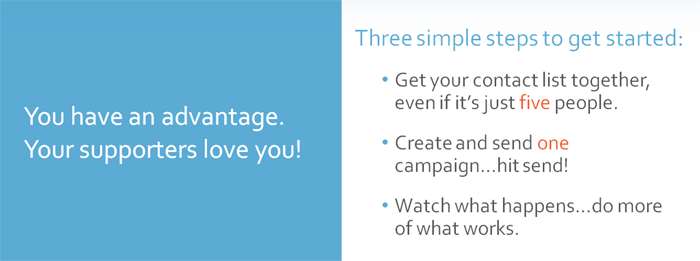
One of the best things I can tell you is that, as a nonprofit, you actually have an advantage. You have an advantage because you, your staff and your supporters can be the face, the people your audience associates with your organization or cause. You can be your authentic self.
If you haven’t yet started with email marketing, or if you haven’t sent a message in a while, try this: Get your contact list together, whether it’s five people or 500 people. Try putting one email campaign together and hit that send button. Keep an eye on what happens next. You’ll start to see what works. Do more of what makes you successful.
We’ve made creating a great email easy for you. We took the best practices we talked about, as well as some pro tips and created a checklist. Print this out later on when you get the slides, and use this checklist when you’re designing and sending your next email.
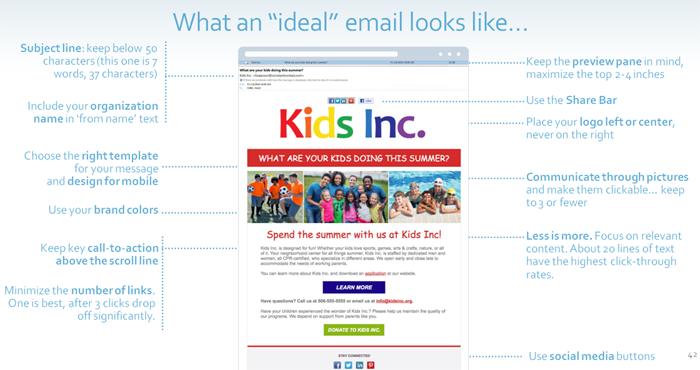
First of all, think about the preview pane. It’s common for email recipients to use the preview pane in their inbox on a desktop, and they’re getting their first look at your email there. If they’re opening your email on mobile, the top section is the first section they see. Maximize the top 2 to 4 inches, keeping all the best practices in mind that we covered today.
– Think small with your subject line. Write your subject lines between 6-10 words. Use the important keywords at the beginning in case the rest of your subject line gets cut off by mobile phones.
– Include your organization’s name in the from name text so your recipients recognize you right away.
– Make your emails shareable for your readers and for you. Including a share bar at the top of the email allows your readers to post a link to your email to their social media profiles.
– The email template you use must be a good fit for the information you’re sharing in your message. What are you trying to communicate? Is it information in a newsletter? A promotion? A business letter? The right template will organize what you’re trying to convey and make you look professional. The template should also be mobile friendly. Stick to a one-column template that won’t shrink to fit or get cut off by a smartphone screen.
– Make sure your branding is visible right away. Include your branding colors. Your logo should be visible at the top of the email, either on the left or in the center. Never on the right side because it can get cut off on a smartphone screen. When you insert your logo, make sure that you include your business name in the text description. Sometimes images aren’t visible by default, based on the recipient’s email service. If that happens, the text will appear instead, and you want your business name to be what they see if your logo isn’t shown.
– Speaking of logos and images, make them clickable. People assume that images are linked to a website, so take advantage of that behavior and link your images to allow readers to take the next step. Choose your photos wisely, and don’t overdo it with images. Stick to 3 or fewer images to get higher click-throughs. Communicate your message through the images you choose. Take your own photos or use stock photography. Size your photos to fit your template. Optimize them by including information about your message in the text description, so the text will appear in case the images aren’t automatically downloaded.
– Be selective with the content you include in your email. Don’t include any content that isn’t relevant to the message you’re sending in an individual email. Most people do not have the time to read through a lot of extra information. Remember that emails with 20 lines of text receive higher click-through rates.
– If you have calls to action – like asking people to volunteer, donate, register for an event, or read an article on your blog – make sure they are above the preview pane scroll line and appear near the top of the screen on a mobile device. Don’t make people search for that key action. Be mindful of the links you use for those calls to action. Don’t just put “click here” when it comes to links in an email. Choose the words you use carefully. Clearly state the value your readers will get when they click on the link. Format your link to stand out, remember that you want it to have enough white space around it, and make sure links aren’t on top of one another. More and more people are viewing emails on their mobile device, and if they are unable to click the link they want because it’s too close to another, how likely do you think they are to go back and click the correct link?
– Don’t ignore social media in your emails. Adding social media buttons that are linked to your business’ social media networks can increase your followers because it makes it easy for readers to click and like you. Using the Social Share tools to schedule posts about your email on Facebook, Twitter, and LinkedIn enables you to share your message to even more people.
Emails with three or fewer images and approximately 20 lines of text result in the highest click-through rates from email subscribers. SOURCE: Constant Contact Data Reveals Direct Correlation between Email Campaign Effectiveness and Number of Images and Text Lines Featured https://news.constantcontact.com/research/constant-contact-data-reveals-direct-correlation-between-email-campaign-effectiveness-and-n
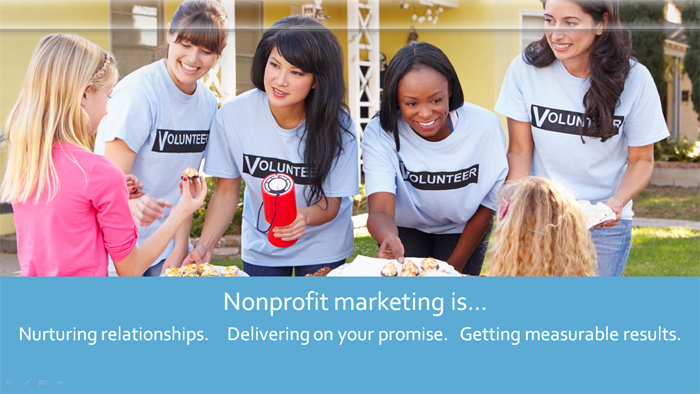
When you really think about it, nonprofit marketing comes down to three things:
1. Nurturing the relationships you develop with your supporters, members, volunteers and donors;
2. Delivering on the promises you make to them before you start communicating;
3. Getting measurable results that help you carry out your mission.
You might be sending email updates, running your own special offers or deals, or getting online feedback or run an online survey. No matter what you’re trying to achieve, Constant Contact has the tools, knowledge, and experts to help you get there.
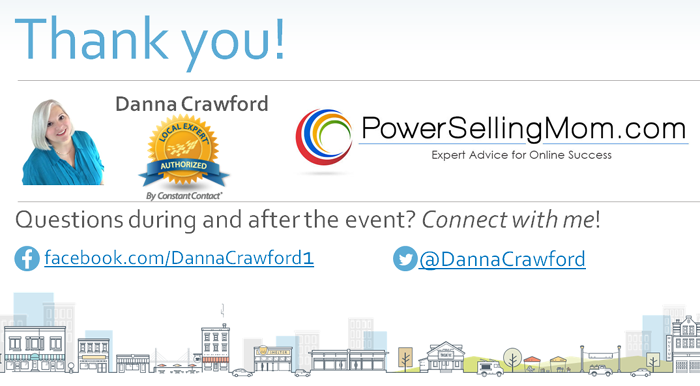
ENJOY the video replay:
Not using Constant Contact yet? Contact me to see what discount is currently available.

